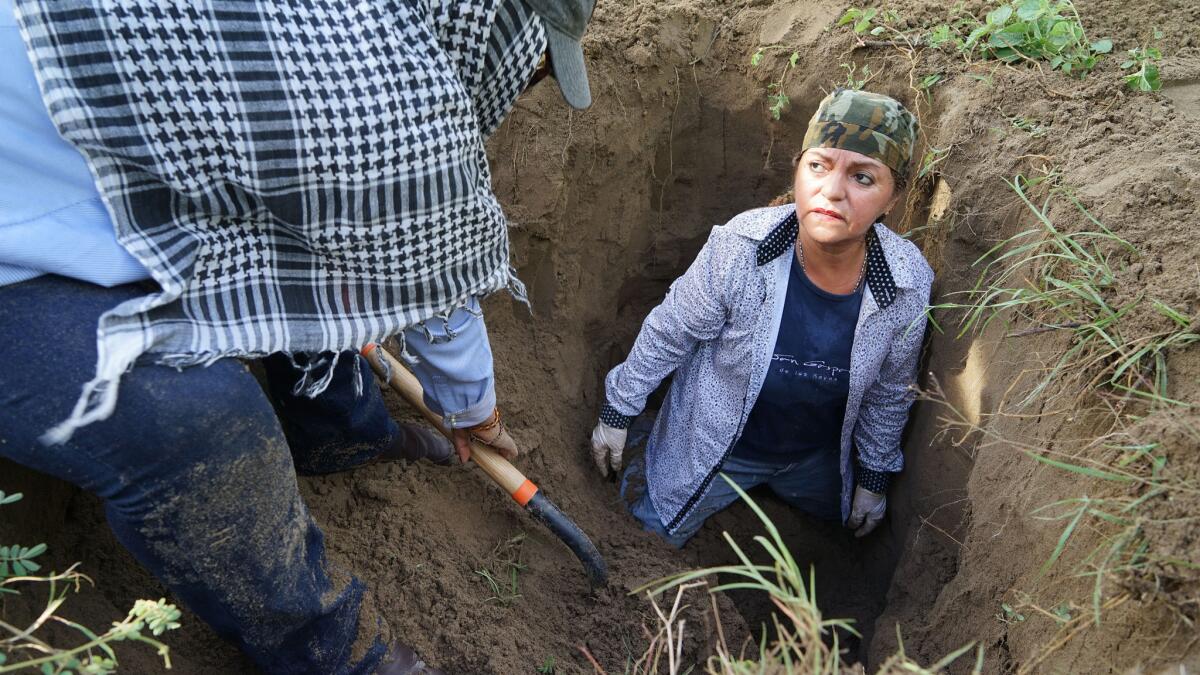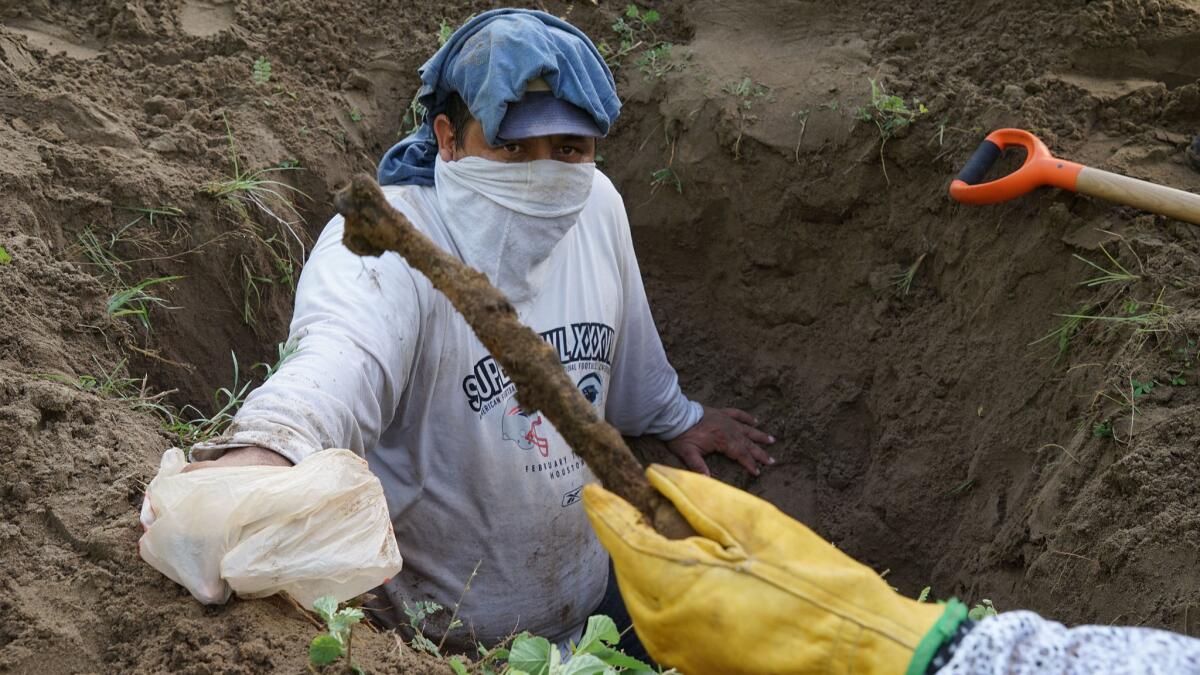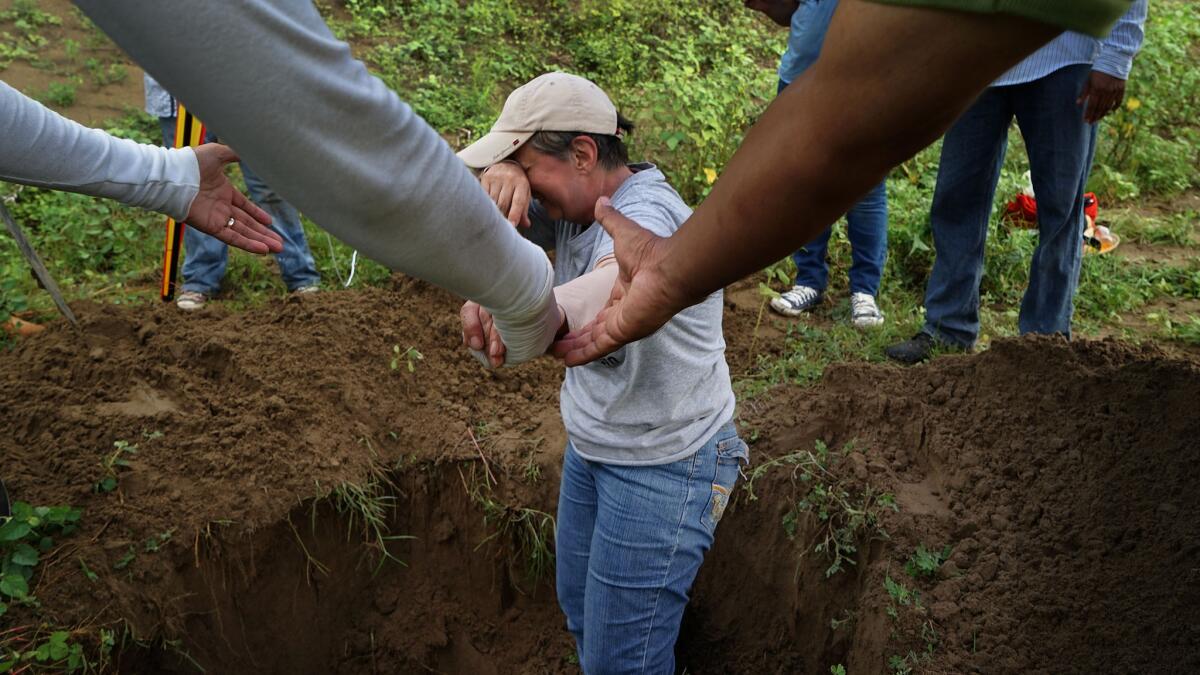‘Mexico is one big cemetery’: The search for the secret graves of ‘the disappeared’

In Veracruz, Mexico, volunteers have been searching for clandestine graves.
Reporting from VERACRUZ, Mexico — They gather shortly after daybreak outside a minimarket, the tropical heat thickening, the dawn haze in lethargic retreat. They hug and catch up, purchase water and snacks for the upcoming ordeal. New volunteers are welcomed.
“You’re not alone,” Lucia Diaz, a leader of the group, assures a young woman on her inaugural outing. “We are all sharing in this together.”
They lug basics: shovels, machetes, hammers, a metal rod to test the earth, a portable canopy to block the broiling sun. Diaz and about 15 others head off in several pickups, passing a police guard and arriving at a mosquito-infested field where everyone sprays on repellent and dons masks and gloves for the grisly task ahead.
Their objective: human remains, long buried, now emerging from the earth, providing clues to unspeakable fates.
Searchers on the northern fringes of Veracruz say they have uncovered at least 80 clandestine graves in the last eight weeks.
The men and women combing this inhospitable stretch are part of an extraordinary, nationwide movement — grieving relatives and friends who took up shovels and picks after exasperating rounds of visits to police stations, hospitals, shelters and morgues. They complain that police, often implicated in illegal abductions — sometimes in cahoots with criminal gangs — have mostly taken reports and done little more.
Mexico’s decade-long, military-led crackdown on drug cartels has swelled the multitudes of desaparecidos — the “disappeared” who vanish without a trace. Their ranks include many with no known link to criminal gangs — kidnapped for ransom, robbery or revenge, or caught in the wrong place at the wrong time.
Led by a tip, brigades of volunteers with their rudimentary tools have combed the field adjacent to a residential district called Colinas de Santa Fe on an almost daily basis since Aug. 2.

If these aren’t our loved ones buried here, they are someone else’s sons and daughters. It’s like they are crying from the ground to be found.
— Martha Gonzalez, mother of missing policeman
“If these aren’t our loved ones buried here, they are someone else’s sons and daughters,” says Martha Gonzalez, who joined Diaz and other volunteer searchers this morning. She is determined to learn what happened to her son, Luis Alberto Valenzuela Gonzalez, a police officer who disappeared three years ago. “It’s like they are crying out from the ground to be found.”
Killers routinely remove all traces of ID on their victims, and authorities have yet to link any of the missing to the bone fragments, skulls, teeth, hair and clothing unearthed here, often concealed in black plastic trash bags.
“We know that in one grave we found 15 black bags,” says volunteer Rufino Bustamante Rosique, whose son is among the missing. “In another grave we found 15 skulls.”
“Mexico is one big cemetery,” is the oft-repeated lament on social media missing persons forums.
Catalyzing the search movement was the disappearance on Sept. 26, 2014, of 43 students from the town of Ayotzinapa, in Guerrero state. The push by relatives to uncover the fate of the students — presumed slain in a case implicating local officials and police — inspired the improbable wave of widows, parents, siblings and friends of the disappeared assuming the role of amateur forensic anthropologists.
“For years, many of us felt isolated, like we were the only ones going through this,” recalls Diaz, who has been consumed by the search for her son, Luis Guillermo Lagunes Diaz, a popular disc jockey and events promoter in Veracruz who was last seen June 28, 2013. “We have since found out there are hundreds, thousands of others going through the same emotions, the same pain. Now, we can share it.”
Lagunes was 29 when he vanished, apparently abducted from his home by an armed gang.
A photo of Lagunes, smiling in black glasses, adorns a beach-side billboard asking, “Have you seen him?” The billboard, part of a nationwide initiative by the Mexican attorney general’s office, offers a modest reward for information on Lagunes or others illegally “deprived of their liberty.”
Diaz helped found El Solecito Collective, the group making the grim discoveries in Colinas de Santa Fe. The collective grew from a WhatsApp chat group and has more than 50 members, mostly mothers and wives of the disappeared.
The collective has badgered state and federal authorities for help. “They will not stop me!” Diaz declared during a Mother’s Day rally in May. Addressing her absent son, she said, “God gave me the joy to have you. He will surely grant me the joy of finding you.”
During the rally, young men distributed what appeared to be advertising fliers and quickly left. The women paid scant attention at first, but the papers turned out to be hand-drawn maps of the field in Colinas de Santa Fe, marked with crosses. The activists suspect that criminal elements turned over the blueprint in an act of compassion for the relatives of the disappeared.
Last year, authorities responding to a tip from an inmate had found scattered human remains in the field, but the case apparently was never pursued. The collective pressured authorities and finally received permission to enter the site in August. Forensic anthropologists provided training sessions on what to look for and how to proceed.
Providing experience on-site has been Guadalupe Contreras, whose fame has spread under the moniker El Ultimo Buscador — the final searcher.
His son, Antonio Ivan Contreras, an auto mechanic, disappeared four years ago, apparently while working in his shop in Guerrero. Contreras, 58, suspects he may have been killed for his new motorcycle, which, like his son, was never found. The stress of the son’s disappearance contributed to the premature death of his wife, Contreras says.
“The government always says nothing is there,” says Contreras, referring to official incredulity of the reports of clandestine graves. “But we have provided the proof.”
Following the notorious Ayotzinapa case, Contreras joined the search movement and became expert at using a metal rod to probe the earth for possible remains. He focuses on subtle clues: signs of digging, trash, discarded clothing. He has been credited with finding dozens of graves in Guerrero.
Sometimes, after shoving his metal rod deep into the ground, he pulls it up and holds the tip to his nose, sniffing for the scent of decomposition.
He brought his singular expertise to Veracruz and this morning the activists begin digging in several spots. The volunteers take turns churning the earth, most using the shovel, though Gonzalez, her head wrapped in a camouflage-print bandanna, gets on her knees and piles handfuls of dirt onto shovel, which a volunteer lifts out of the hole.
Her son and seven other municipal policemen went missing on Jan. 11, 2013, from the nearby town of Ursulo Galvan. He was 24. Relatives suspect state police acting in tandem with traffickers.
Bustamante lost a son too. Cristo Bustamante, a beach-side trinket vendor, was 26 when he was detained by armed men two years ago on a busy Veracruz street.
“The pain of seeking a disappeared son is very great,” says Bustamante. “Desperation has us looking for them in clandestine graves. But we proceed not knowing what we are going to find.”

The burly Bustamante, a refrigerator repairman, carefully shovels the sandy earth to precise measurements. The searchers dig down to about 7½ feet, and at the moment just his shoulders and head appear above ground level. His white Super Bowl XXXVIII sweatshirt quickly becomes spattered with mud and grime.
“We are not trying to bring anyone to justice for what happened — that is the purview of the authorities and the judicial system,” says Bustamante. “We just want to find our sons and daughters.”
Though their aims are finely focused, the searchers’ efforts have inevitably cast a harsh light on the pervasive culture of lawlessness that has long bedeviled Mexico’s criminal justice system.
In one of the most publicized cases in Veracruz state, two top state police commanders, along with other police officials, were arrested in January and accused of complicity in the “forced disappearance” of five youths who were waylaid in the town of Tierra Blanca while returning by car from a birthday celebration in Veracruz city. Authorities suspect police handed the five over to members of a drug cartel.
In the last decade, spiraling violence has battered this tourist mecca that had long been among Mexico’s safest and most carefree zones. Competing gangs, including the ultra-violent Zetas, square off for control of a strategic hub for drugs and migrants headed north to the United States.
Veracruz state officials put the number gone missing in the last decade at about 1,000 — mostly boys and men between the ages of 17 and 29 — though many say the figure is much higher, especially because some fearful relatives don’t report cases. Nationwide, Mexican officials acknowledge about 28,000 “disappeared,” with some cases dating to the 1970s, though activists say that number also is probably an underestimate.
Bustamante continues digging and is breathing hard when he hauls up a black plastic bag. Later, something pokes through the dirt — teeth. Further digging reveals the jaw.
Gonzalez, now wearing a blue surgical mask, kneels by the hole, and Bustamante hands her what appears to be a long bone. She sets it down gently.
Diaz quietly murmurs, “May God grant them peace.”
Later, the searchers tally their finds: the jaw, a skull, leg bones, four black plastic bags.
“Hair,” says one volunteer, logging everything in a notebook. Rosalia Castro, a dentist whose only son vanished almost five years ago, tells him, “Hair that appears dyed.” She adds, “Red.”

Authorities here have not commented publicly on the dig, beyond confirming that some human remains have turned up. The volunteers do the searching, but it is the responsibility of an on-site police forensic team to analyze evidence and remove it for DNA testing.
“We are finding things that authorities never wanted to look for,” Castro says. “We are doing their work, because we want to find our children.” Like some volunteers, she wears a T-shirt with the slogan: “Searching With Dignity and Respect.”
Her son, Roberto Carlos Casso Castro, was a teacher and owned a sporting goods store. He was 38 when he vanished, along with his girlfriend, on Dec. 24, 2011. They had been headed to Castro’s house for Christmas Eve dinner and never arrived. She suspects a case of mistaken identity tied to Veracruz’s toxic alliance of drug traffickers and crooked politicians may have brought about her son’s misfortune.
Castro, 61, also takes a turn shoveling earth. While standing in the pit, she breaks down in tears, covering her face with a forearm as others reach out to steady her.
“We are in the government’s sights, but we have no fear,” Castro says, recounting threats that she and others from the collective have received. “Because of the disappearance of my son, I am already dead in life. What more can I fear? We have a great responsibility. Now that we have begun, we have no intention of stopping.”
Twitter: @mcdneville
Cecilia Sanchez of The Times’ Mexico City bureau and special correspondent Liliana Nieto del Rio in Veracruz contributed to this report.
ALSO
Fears of Mexico’s economy grow as the peso nears the 20 to the dollar mark
In sad ritual, families of Mexico’s missing persons line up to give DNA samples
More to Read
Sign up for Essential California
The most important California stories and recommendations in your inbox every morning.
You may occasionally receive promotional content from the Los Angeles Times.









